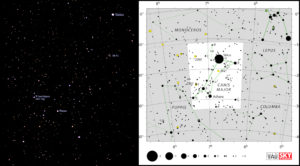
The field around Sirius as imaged by the author, February, 1986 using a 20 cm Newtonian Astrograph. The “cross” is an artifact of the telescope’s secondary-mirror support system.
This is the fourth installment of our ten-part series on the brightest stars and, with it, we’re pleased to present Sirius, the brightest star in Canis Major, the Great Dog. As we transition to winter, with the Winter Solstice occurring this year on the 21st of December (don’t forget to watch the Conjunction of Jupiter and Saturn on that date) with its cold, clear nights, it is only fitting that we present Sirius. At 8.6 light-years distant, Sirius is the brightest star in the sky, in either the northern or southern hemispheres. The second and third brightest stars after Sirius are Vega, at number 3 and Arcturus at number 2. Both Sirius and Vega are A-class stars with Sirius being the closest at 8.6 Ly and Vega at 25 Ly. Sirius with Canis Major is prominently placed due SE at about 9:30 EST during this month and will remain visible well into March.

Canis Major as imaged by the author from the Florida Everglades, January 1986 on the occasion of his trip to observe the apparition of Halley’s Comet that year. 5 minute exposure with a 100mm, F/2.8 lens attached to a Canon AE-1. Of note in this image are the galactic star clusters Messier-41 (M-41) and NGC-2362 surrounding the star Tau Canis Majoris (see the following two images).

The galactic (open) star cluster Messier-41 (the 41st object in Charles Messier’s catalog of non-cometary objects). Image credit the author in 1986 with his 20cm (8″) F/7.2 Newtonian Astrograph. 5 minute exposure, HS Ektachrome film (ASA 400).

Galactic (open) star cluster NGC (New General Catalog) 2362 surrounding the star Tau (t) Canis Majoris. mage credit the author in 1986 with his 20cm (8″) F/7.2 Newtonian Astrograph. 5 minute exposure, HS Ektachrome film (ASA 400).

Comparitive image of the author’s image, presented above and the public star chart of this region of the sky. (IAU and Sky & Telescope magazine (Roger Sinnott & Rick Fienberg)). Chart reproduced under the Creative Commons Attribution 3.0 Unported license.
Sirius is among “The Jewels of the Winter Sky“, jewels that include the two galactic star clusters presented above, both of which are stunning in a wide-field telescope or a pair of 10×80 binoculars. This part of the sky has the highest density of the brightest stars, many of which are contained in Canis Major and Orion, to the north and west. In the next article in this series, we’ll be discussing two of those stars in Orion, Betelgeuse and Rigel.
Canis Major, the Great Dog
Orion was a great hunter whom Zeus placed among the stars and whose name derives from Greek mythology. He was gigantic and powerful, a supernaturally strong hunter of ancient times who was born to Euryale, a Gorgon, and Poseidon, god of the sea.
According to Greek lore, Canis Major represented the dog Laelaps, a gift from Zeus to Europa and was also one of Orion’s two hunting dogs, pursuing Lepus the Hare (due south of Orion) or assisting Orion in his battles with Taurus the Bull.
Though strongly associated with Classical Greek mythology, Canis Minor originates from ancient Mesopotamia and is often associated with the Teumessian Fox, a beast turned into stone with its hunter, Laelaps, by Zeus, who subsequently placed them all among the stars as Canis Major (Laelaps) and Canis Minor (Teumessian Fox).
It is written that, as a reward for his faithfulness, Canis Minor was placed along the banks of the Milky Way, a body believed to be a heavenly river and a place where the faithful canine would never suffer from thirst.
Although Canis Minor was one of Ptolemy’s original 48 constellations in which it was defined as a recognizable pattern (stellar asterism), he identified only two stars and hence no depiction was possible.
Sirius is actually a binary star system with the brightest designated as Sirius-A, a stable, “Main Sequence” star producing energy through thermonuclear fusion reactions in its core. It’s companion, Sirius-B, is a telescopic White Dwarf with a 50-year period, a semi-major axis of 19.6 Astronomical Units (1 AU is the distance from the earth to the sun, approximately 150 Million Km) and a mass of 0.95 that of the sun. Unlike the sun, Sirius-A, it is much more luminous with over twice the sun’s mass and thus, if it replaced our sun, it would be 16x as bright in our sky! This scenario is depicted in the accompanying video.
Being almost twice the effective temperature of the sun, it isn’t likely that Sirius is now, or ever will be, host to any life-bearing planets. Stars in this luminosity class have a productive life-span of no more than 1.5 billion years, a factor of almost ten less than our sun, a star with a productive life-span of about 11 billion years. These stars are thus, too short-lived for life to emerge and thrive. It took 3.5 billion years for life to grow and evolve here to where it is today. A1V (the Morgan-Keenan spectral classification for Sirius; the sun’s is G2V) stars such as Sirius will have long-since evolved to become red-giants before life could ever get a foothold. Moreover, with a 1-solar mass white dwarf binary, there is no possibility of any stable planetary orbits and, if the white dwarf was captured by Sirius-A, any existing planets’ orbits would be almost immediately disrupted or the planets ejected outright from the star system.
Imagination is more important than knowledge
![]()
An index of all articles can be found here.
If you enjoyed this article, please consider supporting us with a modest donation
or through a subscription on our Patreon Page
Membership at Astronomy for Change is Free!
Unique visits–>


